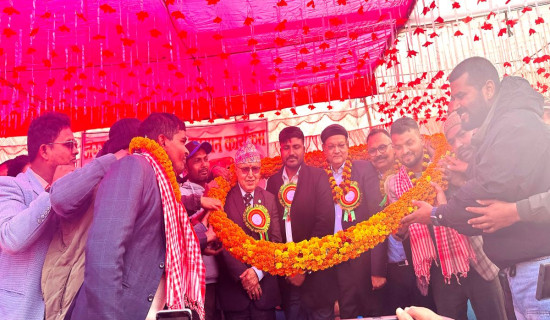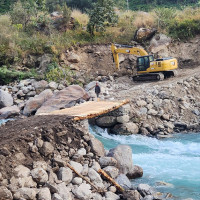- Friday, 26 December 2025
Koshi Tappu witnesses surge of visitors
By Baburam Karki,Barahakshetra, Dec. 7: Domestic and foreign tourists have begun to visit Koshi Tappu Wildlife Reserve, often known as the capital of birds, to observe the winter migratory birds.
The influx of both domestic and international visitors began earlier this year, showing an early surge compared to previous years, according to Koshi Tappu Wildlife Reserve (KTWR) Office.
Binay Kumar Mishra, Assistant Conservation Officer of KTWR, reported that as winter sets in, there is a daily increase in the number of both domestic and foreign tourists visiting the KTWR.
According to Mishra, the winter season sees a higher influx of domestic tourists in KTWR. He noted, "The reserved area has become a primary destination for educational observation tours for students."
As per the office records, there has been a notable rise in the number of tourists coming to witness birds, deer, rhinoceros and elephants. Recent data from the reserve office indicates that around 100 domestic tourists visit the reserve daily.
As winter arrives, migratory birds across the Himalayan region are observed in the border areas of the KTWR, attracting bird enthusiasts to the reserve.
Anish Timsina, a local nature guide and bird expert, highlighted that water birds including various species of goose originating from northern regions such as Siberia, Russia, Tajikistan Tanzania and Tibet can be readily spotted in the wetlands and lakes within the reserve.
During the winter season, birds inhabiting the mountainous regions at altitudes ranging from 2,500 to 3,000 metres in eastern Nepal migrate to the grassy plains and wetland areas of the Terai. Timsina shared that species like Fisto, Chuiya, Bhadrai, and Arjuna have already begun arriving in the reserve and its surrounding areas from various places to seek refuge from the cold.
Winter migratory birds, including the Cotton Pygmy-goose and Lesser Whistling-duck, have already started appearing in the lakes. To facilitate the experience for domestic and foreign tourists, a system is in place for them to visit the reserve for up to 12 hours by obtaining tickets from the reserve office.
Domestic visitors will have the opportunity to explore the reserve by paying Rs. 100 to Rs. 300, depending on the mode of transportation—be it a bike, car, city vehicle or tempo.
Foreign tourists can visit by paying Rs. 1500, while citizens of SAARC countries need to pay Rs. 750 per person to visit the reserve for a day. Each year, tourists from countries like America, Britain, France, China, Russia and many SAARC countries visit the reserve to witness the diverse birdlife and wildlife.
Timsina shared that tourists opt to stay at Saptakoshi Community Homestay, Sudip Homestay, and Aqua Hotel in Barahkshetra-9, which are close to the reserve area.
















